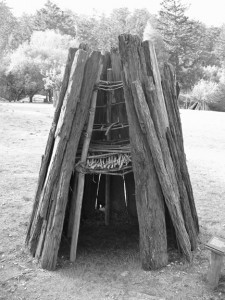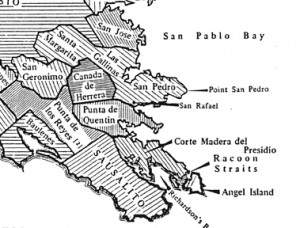San Anselmo was once home to the Coast Miwok, whose origins in Marin County date back 3,600 years. Known for their fine basketry, feather work, and clamshell beads (used as money by tribes throughout California), they lived in small, extended-family villages during the summer and larger, ceremonial and political centers during the colder months.

Redwood bark granary used to store acorns. Replica at Kule Loklo.
Hunters and gatherers, the Miwok survived on food that was fresh and in season. Steelhead and salmon were once plentiful in San Anselmo Creek and several oak species provided acorns that the Miwoks ground for flour and mush. Two archaeological sites have been recorded in San Anselmo, but little research has been conducted.

Mortars and pestles used to grind acorns.
Five thousand Miwok lived in Marin when the first colonizers-the Spanish-began building a network of missions and presidios throughout Alta California, land that they had claimed in 1542 but ignored until Russian fur traders and seafarers from competing nations arrived in the 1700s. Between 1761 and 1823, the Spanish established 21 missions in California, including Mission San Rafael founded in 1817. Diseases introduced by the newcomers, along with relocations from their land, severely reduced the native population, in Marin and elsewhere in the state.
California became part of Mexico following the 1821 Mexican revolution, and for the next 24 years the missions were secularized and large land grants, or ranchos, were awarded to prominent Mexican citizens. Marin was divided into 21 land grants, primarily used for cattle grazing. Three men held title to grants within San Anselmo: Domingo Sais, Juan Bautista Rogers Cooper, and Timothy Murphy.

Rancho Map showing the land grants in San Anselmo
Mexican land grants in San Anselmo.
The Sais family settled in the area in 1835. Four years later, the family patriarch, Juan Maria Sais, sent his son Domingo, then 33, to the territorial capital at Monterey to secure the title to their land. Domingo had the grant issued in his name, a brazen act that ignited a simmering family feud, and his father moved to Sausalito. Domingo’s 6,658-acre a Canada de Herrera rancho encompassed the northwestern half of San Anselmo beginning at Red Hill and including Sleepy Hollow. He dubbed his land La Divina Providencia (“Divine Providence”), and in 1840 built San Anselmo’s first structure, an adobe home on the hill above today’s Sais Avenue. Domingo fell from a horse in 1853 and died without a will. Family legal disputes and sales of small portions of the land led to the breakup of the rancho.
The second land grant of 8,877 acres was awarded in 1840 to Englishman John Rogers Cooper. A sea captain, Cooper became a Mexican citizen, changed his name to Juan Bautista Rogers Cooper, and married a sister of Mexican General Mariano Vallejo. Cooper’s Punta de Quintin, Corte de Madera, La Laguna y Canada de San Anselmo ran southeast from Red Hill to Corte Madera and Point San Quentin.
Timothy Murphy became the third and largest land owner, claimant to San Pedro, Santa Margarita and Las Gallinas, an immense 21,678-acre grant that included 200 acres within the borders of modern San Anselmo north of Red Hill Avenue. An Irishman, Murphy was famous for his size and strength. He came to California in 1828, became a success in the otter fur trade, and in 1837 was named administrator of Mission San Rafael. Murphy also served as San Rafael’s mayor and justice of the peace before his death in 1853.
By the 1840s, tensions between the U.S. and Mexico were reaching a fevered pitch with rumors that Mexico planned to cede California to England to help pay off its debt to the British government. A group of settlers near Sacramento, believing the transfer was imminent, absconded with Mexican army horses, rode them to Sonoma, and demanded the surrender of General Vallejo.
Vallejo, who had been sympathetic to the American cause, surrendered, and the settlers declared their independence from Mexico. In July, the short-lived Bear Flag Republic of California was officially annexed by the U.S., and in September 1850, California became the 31st state.

